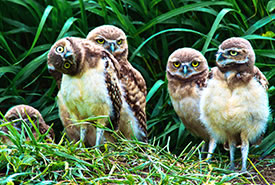Missouri Coteau Natural Area

Burrowing owls (Photo by Don Dabbs)
The Missouri Coteau is a North American glacial moraine of roughly 7 million hectares (17 million acres). Of this, about 3 million hectares (6 million acres) located in Saskatchewan. It extends northwest of the international boundary, follows the South Saskatchewan River and ends just west of Saskatoon.
Habitat and species
Characterized by large tracts of native prairie and high density potholes and lakes, the Missouri Coteau is vital for breeding waterfowl, especially northern pintail. These prairie pothole wetland complexes are also critical for migrating shorebirds. They provide habitat for:
- piping plover
- burrowing owl
- Sprague’s pipit
- ferruginous hawk
- loggerhead shrike
- long-billed curlew
- yellow rail
- northern leopard frog
- monarch butterfly
Threats
Ever present is the threat of cultivation of native prairie patches. Cultivation fragments wildlife habitat and increases vulnerability to the invasion of exotic species. It also reduces the overall sustainability of native plants and animals.
Conservation status
With a high diversity of species and generally large tracts of native habitat still intact, the Missouri Coteau remains a priority for the Nature Conservancy of Canada (NCC) and other conservation organizations. In addition to protecting our native plants and animals, conservation planning has the potential to enhance rural economic development by supporting nature-based tourism in the area.
The Missouri Coteau is a key focus area for NCC.




